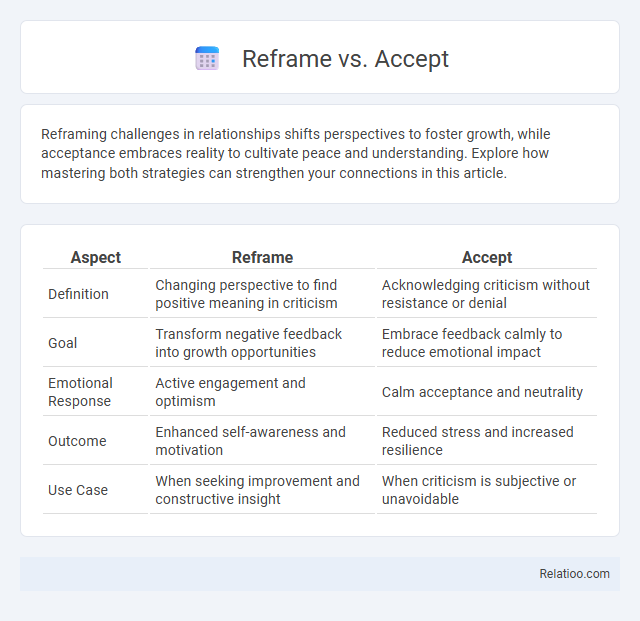Reframing challenges in relationships shifts perspectives to foster growth, while acceptance embraces reality to cultivate peace and understanding. Explore how mastering both strategies can strengthen your connections in this article.
Table of Comparison
| Aspect | Reframe | Accept |
|---|---|---|
| Definition | Changing perspective to find positive meaning in criticism | Acknowledging criticism without resistance or denial |
| Goal | Transform negative feedback into growth opportunities | Embrace feedback calmly to reduce emotional impact |
| Emotional Response | Active engagement and optimism | Calm acceptance and neutrality |
| Outcome | Enhanced self-awareness and motivation | Reduced stress and increased resilience |
| Use Case | When seeking improvement and constructive insight | When criticism is subjective or unavoidable |
Understanding Reframe and Accept
Understanding the difference between Reframe and Accept is essential for effective emotional regulation and cognitive flexibility. Reframe involves changing your perspective on a situation to find positive or constructive meanings, while Accept emphasizes embracing reality as it is without resistance or judgment. Your ability to discern when to reframe versus when to accept influences resilience and overall mental well-being.
The Psychology Behind Reframing
Reframing involves altering the way a situation or thought is perceived to change its emotional impact, often used in cognitive-behavioral therapy to reduce distress and promote adaptive thinking. Acceptance focuses on acknowledging and allowing thoughts or feelings without judgment, fostering emotional regulation and mindfulness. The psychology behind reframing highlights its role in shifting cognitive appraisals to break negative thought patterns and enhance resilience, whereas acceptance builds tolerance and reduces avoidance by embracing present experiences.
The Power of Acceptance in Daily Life
The power of acceptance lies in embracing your current reality without resistance, fostering emotional resilience and reducing stress. Reframe techniques shift your perspective by identifying positive aspects or alternative meanings, but true peace emerges when you fully accept situations as they are. Integrating acceptance with reframing enhances your ability to navigate challenges, promoting inner calm and well-being in daily life.
When to Choose Reframing Over Acceptance
Reframing is preferable over acceptance when an individual seeks to actively change their perspective on a challenging situation to promote psychological flexibility and problem-solving. Choosing reframing makes sense when cognitive restructuring can lead to improved emotional regulation or motivation, especially in cases of anxiety or negative self-beliefs. Acceptance is more appropriate when the stressor is uncontrollable or permanent, whereas reframing works best with situations that can benefit from altered interpretations or mindset shifts.
Benefits of Reframing Negative Thoughts
Reframing negative thoughts transforms harmful perceptions into constructive perspectives, reducing stress and enhancing emotional resilience. Unlike simple acceptance, which involves acknowledging thoughts without judgment, reframing actively challenges and modifies cognitive patterns to foster optimism. This technique promotes mental well-being by encouraging adaptive thinking, improving problem-solving skills, and increasing overall psychological flexibility.
Acceptance: Embracing Reality Without Resistance
Acceptance involves embracing reality without resistance, allowing you to acknowledge your current situation without judgment or denial. This mindset reduces mental struggle by fostering peace and clarity, contrasting with reframing that shifts perspectives and may add cognitive effort. Prioritizing acceptance helps you cultivate emotional resilience and genuine self-compassion amid challenges.
Common Situations: Reframe vs Accept
In common situations such as workplace challenges or personal conflicts, reframing involves changing the perspective to highlight positive aspects or new opportunities, while accepting emphasizes acknowledging reality without attempting to alter perception. Reframe strategies improve problem-solving by shifting focus from obstacles to solutions, whereas acceptance fosters emotional resilience by reducing resistance to circumstances. Choosing between reframe and accept depends on whether the goal is to influence mindset or to cultivate peace with the present moment.
Practical Steps to Master Reframing
Mastering reframing involves recognizing negative thoughts and consciously shifting your perspective to find constructive meaning in challenging situations. Practical steps include identifying automatic negative beliefs, questioning their validity, and replacing them with positive or neutral alternatives that empower your thinking. Your ability to reframe effectively enhances emotional resilience and promotes proactive problem-solving, distinguishing it from mere acceptance or rejection of reality.
Developing Acceptance Skills
Developing acceptance skills enhances your emotional resilience by teaching you to embrace difficult feelings rather than resist them. Acceptance involves acknowledging your experiences without judgment, fostering a calm mindset that reduces stress and promotes mental well-being. Reframing shifts your perspective by interpreting situations differently, but true growth comes from combining acceptance with reframing to create lasting positive change.
Reframe and Accept: Integrating Both for Growth
Reframe and Accept are powerful cognitive strategies that enhance personal growth by shifting perspectives and embracing reality. Reframe involves changing the way a situation is perceived to find positive or constructive meaning, while Accept emphasizes acknowledging circumstances without resistance to reduce emotional distress. Integrating Reframe and Accept fosters resilience, as accepting situations as they are creates a foundation for cognitive reframing to generate adaptive, empowering insights.

Infographic: Reframe vs Accept
 relatioo.com
relatioo.com